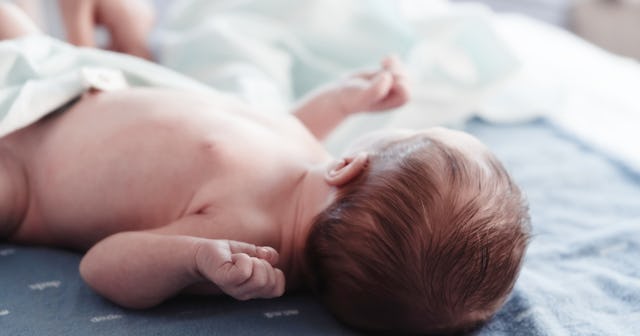Is Your Baby's Umbilical Cord Infected? How To Tell (And Other Care Basics)

When you’re a parent, you witness a lot of somewhat disturbing things. Case in point? The umbilical cord. While the umbilical cord, in itself, is a beautiful thing (since it’s how you nourished your child while in utero), it’s also a topic that people don’t love to discuss. Because, well, not many people have to deal with umbilical cords or umbilical cord care for long in their life. From cutting to drying out, though, it’s a key stage in your baby’s development.
RELATED: Are All Babies Born With Blue Eyes And, If So, When Will They Change?
Basically, umbilical cord care is all part of the newborn years! But if your newborn is suffering from umbilical cord bleeding or an umbilical cord infection, you’ll want to know what to do. Although, for the record, your pediatrician is the best place to go if you’ve got concerns. For the day-to-day basics, here what you should know.
Newborn Umbilical Cord Care
You’ll likely deal with the umbilical cord stump for about two weeks, during which your main priority is to make sure it continues to heal. Newborn umbilical cord care is fairly easy, but that’s all relative, right? As new parents, feeling overwhelmed is normal. Just remember that you’re not alone, and this is a stage that most new parents still have questions about.
According to Mayo Clinic, the umbilical cord is typically cut after birth as it no longer serves a need. While your baby was in the womb, the umbilical cord was the primary way for them to get the nutrients they needed. But now that’s possible through breast milk or formula, which is given orally. The stump itself is created after the cord is snipped and clamped.
One of the most important things to do is keep the stump dry and uncovered as it naturally airs out. At this stage in life, sponge baths are the best way to make sure the stump heals in time. While water isn’t a bad thing, it can slow down the progress.
Dealing With Umbilical Cord Infection
Since the newborn’s body is technically healing, there’s always a risk for umbilical cord infection. You’ll always want to keep an eye out on a newborn umbilical cord to make sure it’s properly healing.
While doctors do their best with cutting and clamping the cord, germs can still enter at this time. If your baby does develop an umbilical cord stump infection, which is known medically as omphalitis, the good news is that it’s pretty rare. You can tell if a stump has gotten infected if it’s red and warm, or tender. Any sort of pus around that area is another sign of an umbilical cord infection.
The cord may also have a foul smell to it. Umbilical cord odor can vary, sure, but let’s be real: It’s often not the most pleasant smell. But if it smells different from normal or especially bad, it may be time to call the pediatrician — especially if you also notice swelling or your baby expresses discomfort.
Another infection to look out for is umbilical granuloma. This is when a small growth of scar tissue forms on the belly button after the umbilical stump has fallen off. It usually looks like a small red lump or lesion covered in yellow or clear discharge. If the condition worsens, it can lead to fever and inflammation around the belly button.
How to Handle Umbilical Cord Care After the Stump Falls Off
Eventually, the stump will fall off, which will be a sense of relief. If it doesn’t fall off after two weeks, you may want to call your pediatrician just in case there’s an underlying issue. One of the biggest concerns is an umbilical hernia. In babies, an umbilical hernia doesn’t necessarily hurt, but it’s important to take care of immediately. If a baby cries or coughs and you notice a bulge in that area, that may be the culprit. If fever or discomfort follows the umbilical hernia, it’s important to see your pediatrician as soon as possible.
Umbilical cord care is a brief part of your parenting journey, but it’s still very important. Just know that many parents also feel discomfort in dealing with the belly button stump. Think of this process as a beautiful reminder of how you were able to provide for your baby before getting to meet them in person.
What clothes should baby wear before the umbilical cord falls off?
When baby’s umbilical cord is still attached, keep them out of tight or close-fitting outfits. A diaper and loose cotton shirt are more than enough clothes. This will allow air to get to the belly button and help the wound dry faster. We understand how cute onesies are, but hold off on them until the umbilical cord stump falls off and heals completely.
Do babies feel pain when the umbilical cord falls off?
The last thing you want is for your nugget to feel discomfort during this umbilical cord healing process. Thankfully, it’s painless because the cord doesn’t have any nerves. So, when the cord is clamped, it’s no different from cutting your baby’s fingernails. Now, if your baby’s belly button is infected, they may experience some pain or soreness.
Other Helpful Information
Now that your baby’s umbilical cord has fallen off, belly button care doesn’t stop there. It’s important to keep your baby’s navel clean because it can become a dirty place without the proper attention. So, when bathing a newborn, gently wipe the navel with mild soap and water. Then dry the inside with a soft towel or cotton swab. When a belly button is moist, it can become a breeding ground for bacteria and fungi.
This article was originally published on